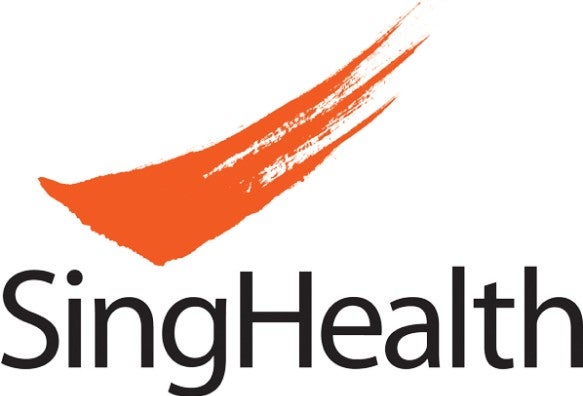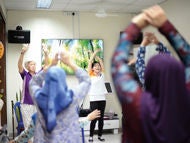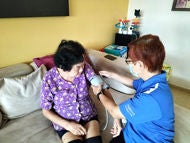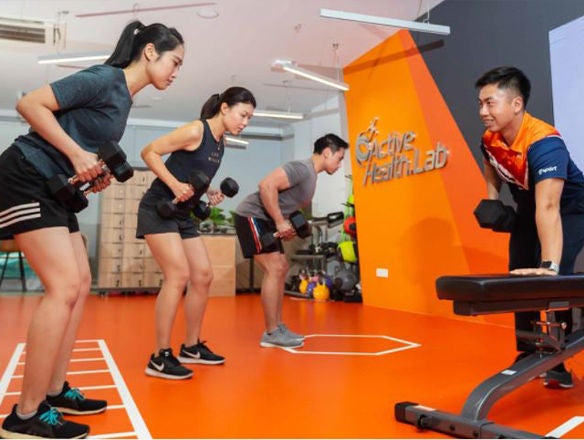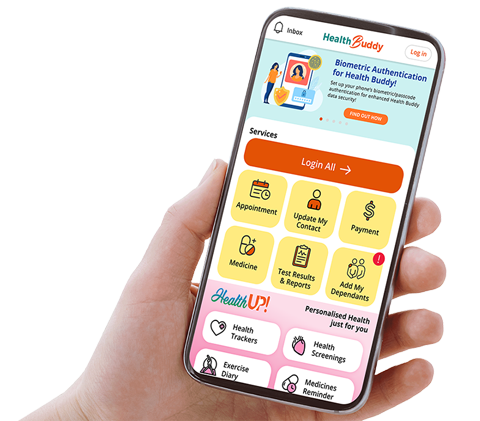Collaborative care across primary, tertiary and community healthcare settings is integral to optimising patient outcomes. Read about SingHealth’s Flow-Hold-Link model, its key initiatives to foster interconnectedness, and how it works closely with partners such as general practitioners (GPs) to champion population health.
INTRODUCTION
Chronic diseases such as hypertension and hyper-lipidaemia currently affect 37% and 32% of our population respectively.1 Additionally, by 2030, one in four Singaporeans will be aged 60 and above.2 To address these healthcare challenges, Singapore has shifted from a hospital-centric model to an integrated healthcare approach.
SingHealth’s Flow-Hold-Link care model exemplifies this transformation, connecting hospitals and primary and community care providers in a seamless network. This transformation, supported by the national Healthier SG initiative, encourages preventive care through regular general practitioner (GP) engagement and community partnerships. SingHealth, as Singapore's largest public healthcare cluster, plays a pivotal role in pioneering this approach.

THE FLOW-HOLD-LINK MODEL
FLOW stands for:
|
HOLD means:
|
LINK emphasises:
|
Overall, the Flow-Hold-Link model recognises that hospital-based care alone is insufficient to meet the growing healthcare needs of Singapore's population. This model seeks to balance the need for specialised hospital care with the role of primary and community care, ensuring that healthcare is delivered in the most appropriate care setting at the right time.
CARE INTEGRATION VIA THE FLOW-HOLD-LINK MODEL
One of SingHealth's key strategies is care integration that focuses on both treatment and prevention through the Flow-Hold-Link model. Recognising the need for a holistic approach to healthcare, SingHealth collaborates with primary care providers including GPs, and community partners such as social service agencies and active ageing centres (AACs)
Key Initiatives by SingHealth
1. HEALTHUP!
SingHealth's integrated care strategy is exemplified through HealthUP!, its signature preventive health movement. Under HealthUP!, residents are empowered to reach their health goals through a wide range of activities offered by SingHealth and its community partners.
Residents also receive long-term tele- and digital support from a team of SingHealth’s Wellbeing Coordinators (WBCs), benefitting from personalised recommendations for physical activity, healthy eating, health screenings, immunisations, etc.
HealthUP! also facilitates residents’ enrolment into the national Healthier SG initiative. It helps enrolees and their primary care providers reach their co-developed health goals.
Residents can sign up for HealthUP! via the SingHealth Health Buddy mobile app.
2. GOODHEALTH LAB
SingHealth RHS and Montfort Care also collaborated to launch an innovative GoodHealth Lab at the Active Ageing Centre (AAC) Goodlife Bedok on 16 May 2025. This pioneering initiative adopts an innovation-driven approach to integrate health and social support under one roof, transforming care for seniors.
Seniors and caregivers will gain essential knowledge and community connections to enhance their wellbeing – using the lab as a nexus for planning, testing and evaluating joint outcomes while enabling social prescribing through AAC activities, expert-led health talks, support groups and workshops.
This collaboration leverages diverse industry expertise including inviting GPs to deliver holistic interventions that strengthen our community's health resilience.
GPs who are interested to find out more about this collaboration may email to sinma.tham@singhealth.com.sg.
3. PLACE-BASED PERSON-CENTRED CARE APPROACH
SingHealth deploys multidisciplinary care teamsin the community based on a place-based person-centred care approach. This includes the SingHealth Healthier SG Teams, which consist of Community Nurses and WBCs.
The SingHealth Healthier SG Teams work with GPs and their supporting staff to manage patients based on their holistic care needs, offering preventive care, health education and screenings. These efforts aim to detect health issues early and manage chronic conditions effectively within the community.
SingHealth Community Nurses provide nurse led consultations to support residents in areas such as chronic disease management, medication management, care referral and coordination. The WBCs empower them to take charge of their own health through social prescribing and encourage positive lifestyle modifications.
CASE EXAMPLE
Mr Tan, an 80-year-old resident with dementia, was referred to the SingHealth Healthier SG Team by the staff of an AAC. He and his wife struggled with the medication Mr Tan needed to manage his symptoms at home.
Medication management
The SingHealth Community Nurse worked withthe couple to manage Mr Tan’s medication, which included liaising with his geriatric and polyclinic doctors to ensure sufficient medication was delivered to Mr Tan. The couple was also referred to a home care nurse for long-term medication packing.
With medication compliance, Mr Tan’s symptoms are better managed. The nurse continues to monitor MrTan and updates his geriatrician about his condition.
Reducing caregiver burden
As the sole caregiver to Mr Tan, Mrs Tan had caregiver stress. With encouragement from the nurse and WBC, Mrs Tan agreed to send Mr Tan to a daycare service so that she could have some respite care, and she is now better resourced to care for her husband.
The nurse also assisted with applying for the relevant financial assistance schemes to reduce any potential financial burden on the couple.
With the place-based and person-centred caremodel by the SingHealth Healthier SG Team, Mr and Mrs Tan are well-supported within the community to manage Mr Tan’s health in a sustainable way, reducing the couple’s need to visit the hospital for medical care.
4. COMMUNITY HEALTH POSTS (CHPs)
SingHealth Healthier SG Teams are based at the CHPs within the community. Residents have the option to visit their nearest CHPs for a consultation. Alternatively, the SingHealth Healthier SG Teams conduct home visits to assess residents’ care needs. Such efforts ensure that the health and social aspects of a resident’s care are addressed in a holistic manner.
As of March 2025, SingHealth’s support for Healthier SG is reflected in the setup of Healthier SG Teams situated in 132 CHPs across 37 communities of care in the eastern region of Singapore.
5. SINGHEALTH AND PRIMARY CARE NETWORKS (PCNs)4
In Singapore, GPs serve as the first point of contactfor the majority of patients. GP clinics serve about 80% of the population’s primary care needs.
Traditionally, GPs have managed common ailments and routine health checks. With the shift towards integrated care, GPs now play a more significant role in the management of chronic conditions and preventive care.
As of 9 January 2025, 11 PCNs have been formed nationwide, including the SingHealth Partners PCNs (i.e., SingHealth DOT and SingHealth Regional PCNs) which are the largest with 287 Healthier SG PCN GP clinics.
How PCNs work with SingHealth
- Chronic disease management by GPs
GPs within the PCNs work with patients to monitor and manage chronic conditions, with regular check-ups, lab tests and medication management. This minimises delays and improves health outcomes.
- GP collaboration with hospitals
GPs in PCNs can refer patients to SingHealth hospitals for specialist consultations or diagnostic tests, reducing the need to visit the hospital for routine management. This ensures that patients receive comprehensive care at both the primary and specialist levels.
- Subsidised specialist care for patients
Through PCNs, GPs can help patients access subsidised and affordable care at SingHealth’s hospitals.
How can GP clinics join a PCN?
As a pre-requisite, GP clinics looking to join a PCN should participate in all of the following schemes under Ministry of Health:
- Community Health Assist Scheme (CHAS)
- Chronic Disease Management Programme (CDMP)
- Public Health Preparedness Clinic (PHPC)
- Healthier SG Screening
GPs who are keen to join a PCN visit the Agency for Integrated Care website, for more information. GPs need to join a PCN in order to participate in Healthier SG.
SINGHEALTH’S INTEGRATED HEALTHCARE APPROACH
SingHealth’s role in coordinating healthcare
SingHealth is a major player in Singapore’s national healthcare system, overseeing multiple hospitals and specialty centres such as Singapore General Hospital, Sengkang General Hospital, Changi General Hospital, KK Women’s and Children’s Hospital, SingHealth Community Hospitals and National Heart Centre Singapore.
It also operates SingHealth Polyclinics and Community Health Posts to ensure a full spectrum of care ,from acute to preventive services.
SingHealth Regional Health System (RHS)
Simultaneously, SingHealth is the assigned health cluster overseeing population health in the eastern region of Singapore. SingHealth RHS, as the Regional Health Manager, recognises that the population can be empowered to keep well, get well and live well in their communities and home.
The following are the three core centres under RHS which support its mission:
1. SingHealth Centre for Population Health Research and Implementation (CPHRI)
Research, innovate, evaluate
Launched in April 2022, CPHRI aims to serve as the nexus for population health research, implementation and evaluation within the SingHealth Duke-NUS Academic Medical Centre. It bridges research and care delivery into the community, and develops population health expertise to serve strategic needs.
2. SingHealth Community Health Office of Learning (SCHOOL)
Educate to empower
SCHOOL strengthens health and social care integration through its Singapore Community of Practice in Social Prescribing (SCOMP) platform. This initiative trains healthcare and social care professionals, including WBCs, to enhance social prescribing's impact in the community.
Social prescribing refers to connecting patients to local, non-clinical services, fostering new passions and supportive networks. By linking individuals to social activities, social prescribing empowers patients to enhance their wellbeing and supports them in health prevention.
3. SingHealth Centre for Person-centred Care (CPCC) and ESTHER Network
Empower to activate
CPCC’s mission is to enhance care delivery through staff and patient education, while scaling practices and efforts on person-centred care in the community. Under CPCC, the ESTHER Network Singapore develops ESTHER Coaches to drive person-centred improvement work.
OUTCOMES OF SINGHEALTH’S INTEGRATED HEALTHCARE APPROACH
- Enhanced community care delivery with well-facilitated patient transitions.
- A linked network as GPs, hospitals and community partners coordinate and work seamlessly.
- Collaboration between healthcare and social service sectors, ensuring holistic care.
- Outcome-focused care with enhanced management of chronic conditions and strengthened preventive care measures.
- Reduced hospital strain and healthcare costs.
CONCLUSION
SingHealth's Flow-Hold-Link model illustrates Singapore'sshift from hospital-centric care to a community focused approach. Moving forward, the healthcare industry should continue to develop collaborative care programmes and integrated care networks with primary care providers and community partners. Harnessing resources through capability and capacity building leads to a more sustainable healthcare system.
For enquiries on care integration, please email to rhs@singhealth.com.sg.
REFERENCES
1. Ministry of Health, Singapore (2022), National Population Health Survey (NPHS) 2022: https://www.moh.gov.sg/others/resources-and-statistics/nphs-2022.
2. Ministry of Health, Singapore (2023), Action Plan for Successful Ageing: https://www.moh.gov.sg/others/resources-and-statistics/action-plan-for-successful-ageing.
3. Ministry of Health, Singapore (2025): Healthcare Industry Transformation (ITM) Masterplan 2025: https://www.moh.gov.sg/newsroom/launch-of-healthcare-industrytransformation-map-2025.
4. Agency for Integrated Care, Singapore (2019), Primary Care Networks (PCN): https://www.primarycarepages.sg/schemes-and-programmes/primary-care-networks.
Article contributed by:
- SingHealth Office of Regional Health
- Regional Hospital Network, SingHealth
- SingHealth Centre for Population Health Research and Implementation
- SingHealth Centre for Person-centred Care
- SingHealth Community Health Office of Learning
